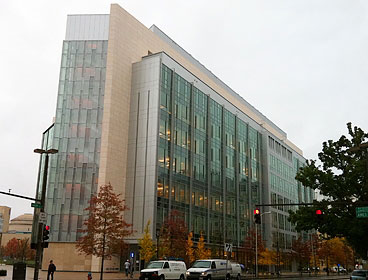| Mar 07, 2011 |
Koch Institute for Integrative Cancer Research at MIT dedicated
|
|
(Nanowerk News) The new seven-story headquarters of the David H. Koch Institute for Integrative Cancer Research at MIT, where scientists and engineers are working together to pursue new ways to treat, detect and prevent cancer, was officially dedicated yesterday at 4 p.m.
|
|
The 365,000-square-foot building, designed by Cambridge-based architectural firm Ellenzweig, stretches along Main Street between Ames and Vassar streets, and houses 27 faculty labs and about 630 researchers, who began moving into the building in October 2010. Scientists and engineers work side-by-side in the new building, fostering collaborations between disciplines such as biology, chemical engineering, computer science, materials science and more.
|
 |
| The David H. Koch Institute for Integrative Cancer Research, as seen from the intersection of Ames and Main streets. (Photo: Patrick Gillooly)
|
|
"Under the leadership of Tyler Jacks, director of the Koch Institute, Koch researchers are cultivating frontier-breaking ideas at the remarkably fertile intersection of biology, engineering and the physical sciences," said MIT President Susan Hockfield.
|
|
Construction of the new building was made possible by a $100 million donation from David H. Koch '62, SM '63. That gift was announced in 2007 http://web.mit.edu/newsoffice/2007/koch-institute-1009.html.
|
|
"David Koch has supported MIT generously over many decades," said Hockfield, "and in this project he has been a true partner. I am grateful not only for his generosity, but also for the passion and insight he has brought to this ambitious undertaking."
|
|
"Of all of the things that I've done philanthropically,'' David Koch said, "playing a major role in the creation of this brilliant cancer institute at MIT is the one I'm most proud of. I hope that in time, hundreds of thousands, if not millions of lives, will be saved around the world because of therapies that originate here.''
|
|
The new Koch Institute joins a part of the MIT campus that has become a meeting ground for multidisciplinary collaboration in biotechnology and the life sciences. It is situated next to the Stata Center for Computer, Information and Intelligence Sciences; across the street from both the Broad Institute and the Whitehead Institute for Biomedical Research; and within walking distance of the MIT Brain and Cognitive Sciences complex. Dozens of biotech and biopharmaceutical companies are located nearby.
|
|
The new building (also known as MIT Building 76) replaces the Koch Institute's former headquarters in Buildings 17 and 18. Most of the engineers who have joined the cancer biologists in the new facility formerly had labs scattered across campus.
|
|
All of the building's common areas are clustered in the center of the building, to help promote chance encounters that could lead to new research collaborations.
|
|
The new building also features the Swanson Biotechnology Center, a 20,000-square-foot cluster of "core facilities" that offer researchers access to cutting-edge technology that their individual labs likely could not afford to purchase. Those include technology for cell imaging, DNA sequencing and nanomaterial characterization.
|
|
In addition to lab and meeting space, the building also features a ground-floor exhibition gallery that will be home to a changing display of art and information on MIT's leadership role in the life sciences.
|
|
Koch Institute research is currently focused around five key target areas: nanotechnology therapy, detection and monitoring, metastasis, personalized medicine, and the immune system. Research and development in each of these areas involves cross-disciplinary teams of faculty, students, and staff ? and will also encompass collaborations with clinical centers and industry.
|
|
"I am optimistic that the work of the Koch Institute will have an important effect on patients' lives, in the near term," said Tyler Jacks, Director of the Koch Institute and the David H. Koch Professor of Biology at MIT.
|
|
"I expect the research that we do will lead to more effective treatments, better ways to monitor the disease, and -- one day -- to prevent it altogether."
|

